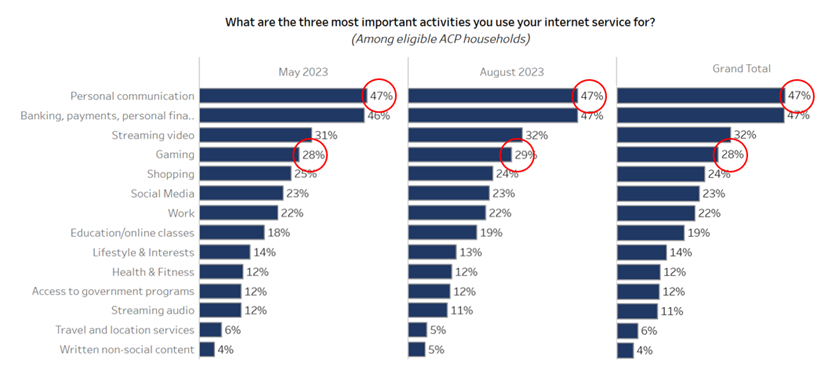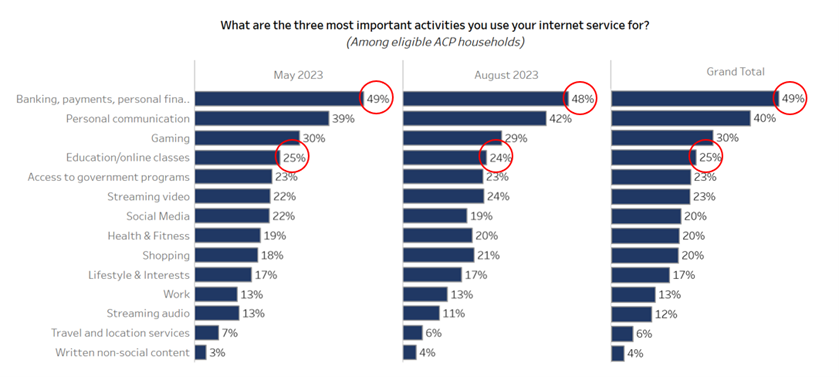Recon Analytics recently conducted the largest survey run to date to assess whether consumers eligible for the Affordable Connectivity Program (ACP) are actually enrolling and if so, what they are using their ACP funds for.
We conducted nationwide consumer surveys among ACP-eligible Americans from April 28 – May 5, and August 18 – 27, 2023. We asked 29,141 ACP eligible Americans if they use ACP, and if so for what.
We were not at all surprised with our survey findings, but some policymakers might be.
Recall that ACP is a program that provides “eligible” Americans $30 per household for internet connectivity. Who is eligible? Figure 1 sets forth the categories of citizens eligible for ACP. These “categories” of low income individuals are from existing federal government subsidy programs.
Figure 1

Of the almost 53 million ACP-eligible households, more than 20 million have signed up. The states with the highest number of consumers receiving ACP subsidies are “red” states Louisiana, Ohio, Kentucky, and North Carolina.
The program is currently set to expire in early 2024 absent additional funding by Congress.The big question inside the Beltway is whether funding the ACP is a good use of taxpayer dollars. The ReconAnalytics survey indicates that if Congress is interested in seeing itself reelected, extending the ACP funding might be a good idea.
The Data Says ACP is Working to Close the Digital Divide … Among Republican Voters
When we compare ACP enrollment across red states and blue states (defined by the party who won the last senatorial election in the state) , we observe that the percentage of households which would lose access to the internet is higher in red states than in blue. 39% of ACP enrollees live in Red States and 34% live in blue states. Members of Congress ignore this reality at their peril.
But what about the enrollees, what are they using their ACP subsidy for? Consider that the largest proportion of households at risk of losing ACP are ones with school-age children. No surprise then that our survey reveals that these same households use their ACP subsidy for school work online.
In aggregate, about 55% of respondents who told us they would be unable to access the internet without ACP were white, 16% Hispanic, 12% black, 9% Asian, 6% Native American or Pacific Islanders and 2% were of another race.
Figure 2 – ACP Enrollees by Race, Ethnicity, Age and Income Distribution
| Full Time Period | |||||
| Income | $0-10k | $10-25k | $25-50k | $50-75k | Total |
| Not able to access the internet w/o ACP | 36.2% | 39.2% | 34.8% | 28.4% | 36.2% |
| Race & Ethnicity Distribution | |||||
| White | 47.9% | 59.2% | 57.5% | 48.9% | 54.5% |
| Hispanic | 18.8% | 14.1% | 17.5% | 15.3% | 16.3% |
| Black | 15.8% | 10.6% | 11.0% | 13.4% | 12.3% |
| Asian | 9.2% | 7.4% | 6.7% | 15.3% | 9.1% |
| Native American & Pacific Islander | 5.4% | 6.9% | 4.4% | 5.3% | 5.5% |
| Other | 2.9% | 1.9% | 3.0% | 1.9% | 2.4% |
| Age Distribution | |||||
| 18-29 | 31.0% | 15.9% | 20.5% | 22.5% | 21.5% |
| 30-44 | 26.4% | 21.2% | 33.6% | 45.0% | 31.0% |
| 45-60 | 34.3% | 40.5% | 32.9% | 25.6% | 33.9% |
| >60 | 8.3% | 22.5% | 13.0% | 6.9% | 13.6% |
In Figure 3, we are looking at the activities that ACP households in general and in Figure 5, ACP households that would lose internet access but for ACP, are engaged in.
We show the data for both survey waves to highlight the consistency of the results over time. The two most used applications for their ACP connections are personal communications and banking, payments, investments and personal finance. In other words, ACP subscribers are using their subsidy to allow them to connect to the Internet and engage in the digital economy, whether it’s paying their bills or buying school supplies for their children. Almost a quarter of ACP recipients use their internet connection for purchases, more than one in five (22%) need their internet connection for work, one in five (19%) for online education, and one in 8 (12%) to access government programs.
Figure 3: Behavior pattern of ACP-eligible Americans regardless of ACP participation

Figure 5 shows the impact of losing ACP. It also shows what applications really matter to people who critically depend on ACP for their broadband connection. Banking and financial transactions, education and access to government programs are priorities for these citizens.
Almost half of ACP recipients would lose internet access altogether if ACP were to go away.

This potential outcome presents a Catch-22: the government has pushed many programs online as a cheaper way to deliver services to low-income Americans. Due to ACP, 22% of the targeted beneficiaries of this policy are receiving those services. If ACP goes unfunded, 22% of the the very Americans Congress says it wants to help out of poverty will be stranded.
Seems like ACP is working but perhaps will be so effective, Congress will kill it, but at their peril.



